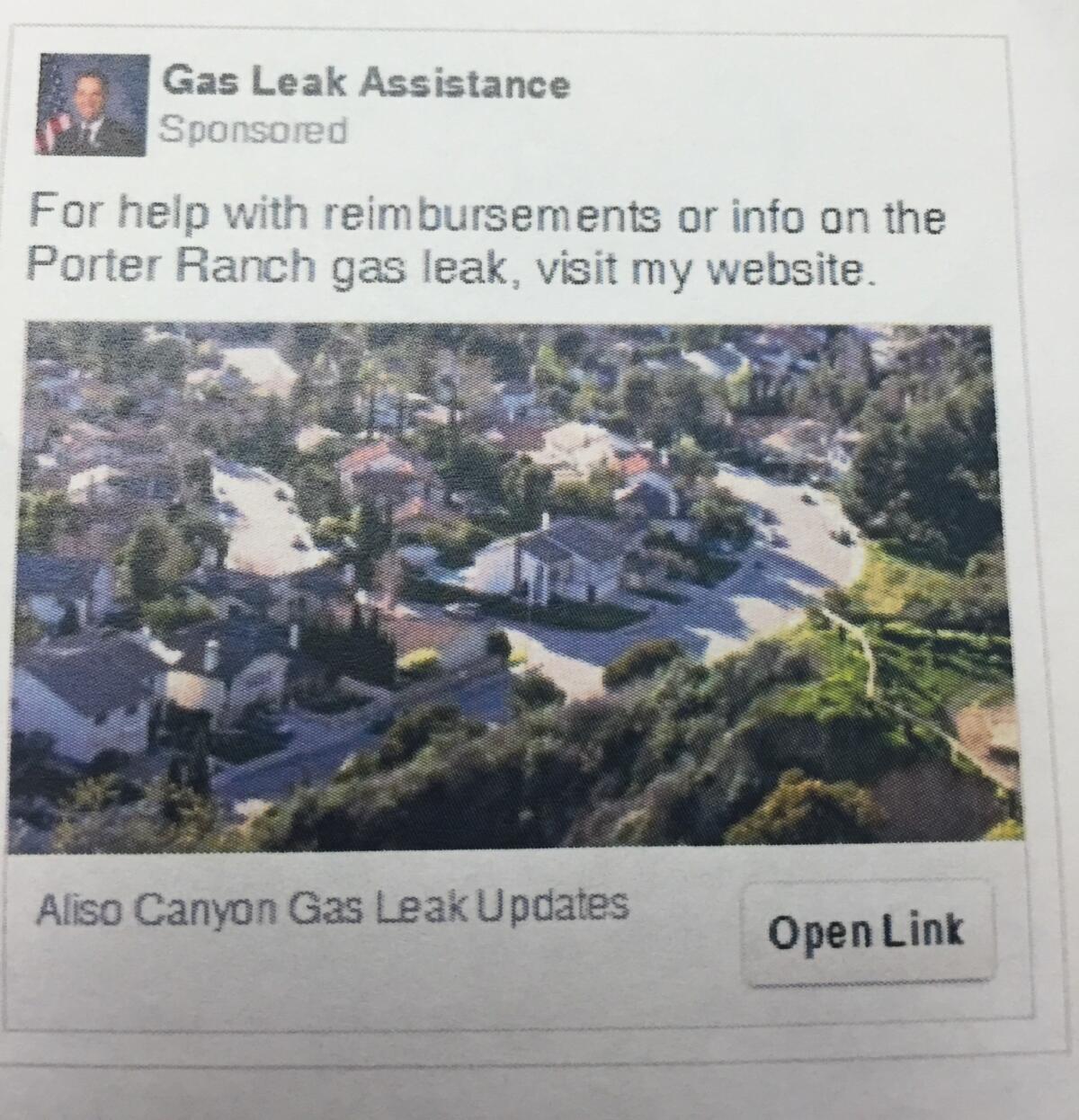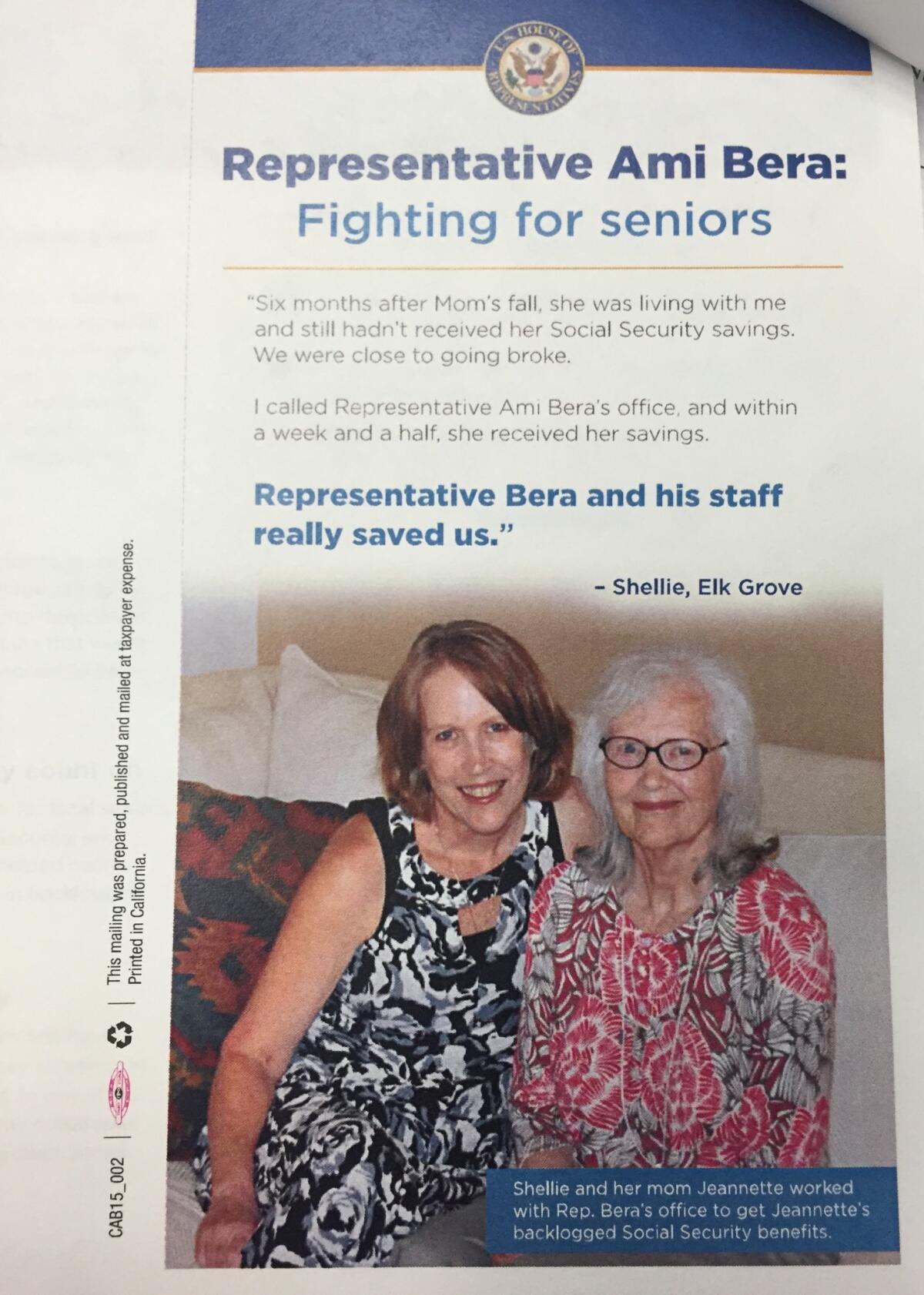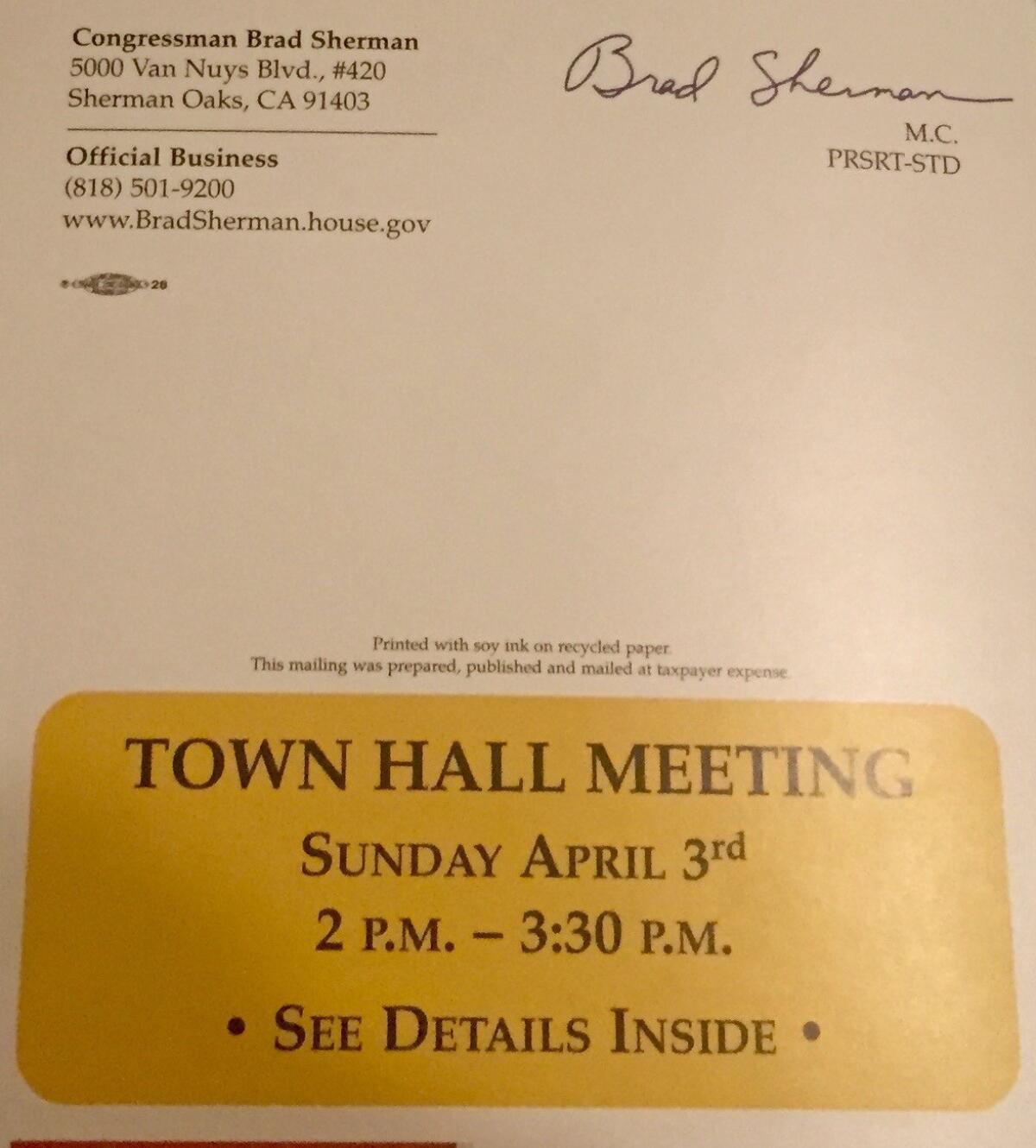These California congressional leaders spent the most taxpayer money communicating with constituents
- Share via
California’s congressional delegation spent $3 million in taxpayer money talking to constituents last year. Almost a third was spent in just five of the state’s congressional districts.
While many members of Congress have turned to free or low-cost ways to reach folks back home, five California members rank among the top spenders on so-called “franked mail,” or taxpayer-funded mass communications.
Franked mail is official correspondence members of Congress send to at least 500 constituents using their signatures, rather than stamps. Members pay the equivalent of postage out of annual office budgets, and each piece must include the statement, “This mailing was prepared, published, and mailed at taxpayer expense.” Franking began in England in the 17th century and has been in use on and off since the United States was founded.
Fifteen of California’s 53 House members spent more than $100,000 in 2015 to talk with constituents through letters, fliers, emails or surveys, even Facebook ads and automated phone calls, a Times review of members’ office spending found.
Among all House members who sent at least one mass mailing or communication, the average cost between 2009 and 2011 — the most recent years for which data are available — was $107,431 each, according to the Congressional Research Service.
The two California representatives who spent the most, Reps. Steve Knight and Ami Bera, serve districts targeted by the national parties as seats where control could be flipped.
Knight, a Palmdale Republican, was pleased to hear that the $204,139 he spent last year is more than any other member of California’s delegation.
“We make a serious effort to communicate,” he said. “Any office reacts to what a community wants, so we want to know what the community wants.”

The House Legislative Resource Center keeps a copy of each piece of mail or communication in storage. Knight’s file includes a telephone town hall script, a pamphlet on constituent services and Facebook ads telling people to call his office for information about reimbursements from the Aliso Canyon natural gas leak last fall. Knight said more than 7,000 people receive his electronic newsletter, “Knight Vision,” every 10 days.
Bera, a Democrat from Elk Grove, also said people in his district like the regular communication through letters, fliers, surveys and social media. He called the $190,089 in mailings and other communications “exactly what we should be doing.”
“A lot of our mailing is about how to access our services, what we can help them with, etc.,” Bera said. “My predecessors who had the office before did very little in constituent services, so a lot of this was educating the folks in the district in how they could use their congressional office.”
Bera’s file includes surveys asking for constituents’ opinions on gun control or money in politics, fliers and Facebook ads about what the office can do to help those in the district.

The other top spenders were Reps. Norma Torres (D-Pomona), who spent $184,867; Mark DeSaulnier (D-Concord), who spent $170,219; and Brad Sherman (D-Porter Ranch), who spent $159,825.
Torres and Sherman said the mail and communications sent in 2015 were responding to incidents in their districts.
Although the San Bernardino shooting wasn’t in her district, it affected her constituents, Torres said, prompting her office to send mailings with public safety information.
The 35th Congressional District was created from parts of three districts when boundaries were redrawn after the 2010 Census, and Torres’ predecessor stayed for only one term. Torres said the amount she spent also went toward making sure constituents knew how her office could help.
“We wanted to make sure they knew, first of all, who their member was. And number two, we wanted to make sure that they knew about the services that already exist in our community and what we can offer them,” Torres said.
Sherman pointed to the months-long gas leak at Aliso Canyon as the cause of his high mail and communication costs. Thousands fled their homes during the leak, and Sherman said he wanted to get them as much information as possible. Now that the leak has been plugged, he said he expects spending to decline.
“We thought we’d space things out over the year, and then we got the gas leak,” Sherman said. “We communicated a lot on the gas leak in November, December, January, February.”
Sherman serves on the House Administration Committee’s Commission on Congressional Mailing Standards, the group of lawmakers tasked with approving or rejecting each communication members want to send out.
He said he uses mass communication and mailings to alert constituents about his town halls, so he’s used to his spending being a bit higher than other offices.
“Almost every one of our mailers is there to announce a town hall. You don’t save much money sending out a little postcard. You get more people to notice your town hall if you send them a big colorful piece of mail,” Sherman said.
DeSaulnier said he uses mailers to inform people in the 11th Congressional District about public meetings and his district offices. He’s serving his first term.
“I wanted to do it aggressively, and I wanted to do a lot of town halls in my first two years because it’s a new office and I wanted to make sure people feel like I was open and available to them,” DeSaulnier said.
He said he might turn to more digital outreach and less physical mail for much of the district, while still sending mail to areas that might not have as much Internet access.
“I want people to know who their congressman is. I think people in a democracy should know who their elected officials are. It’s just you don’t want to spend public funds to appear like you’re running for reelection or promoting yourself,” DeSaulnier said. “It’s a double-edged sword.”

The Times’ review of office spending included both franked mail and mass communications, unsolicited messages from a member of Congress expected to reach more than 500 people, such as radio and Internet ads, telephone town hall meetings and newspaper ads.
Mailings and communications must be about policy or laws and cannot be used to campaign. Members can’t send the mailings within 90 days of an election, so mailings must stop between Aug. 10 and Nov. 8.
Still, the communications are routinely criticized during election years as providing an unfair advantage to incumbents at the taxpayer’s expense.
Some members have stopped using franked mail, instead using the money for their offices in other ways.
A May 2015 report by the nonpartisan Congressional Research Service found that overall spending on mailings and other communications dropped from about $30 million in 2012 to about $20 million in 2014.
Nine California House members didn’t spend any money on mass mailings or mass communications in 2015.
One of them, Rep. Mike Thompson (D-St. Helena) said he’s found ways to communicate with constituents without franking.
“I have a pretty good district outreach program that we’re able to do with minimal mail,” Thompson said.
Thompson spokeswoman Megan Rabbitt said the congressman reaches constituents through social media and e-newsletters. He responded to over 50,000 constituent letters last year, she said.
Rep. Dana Rohrabacher, a Republican from Costa Mesa, uses social media, television interviews and in-person meetings to talk with constituents, his spokesman, Ken Grubbs, said.
“He doesn’t feel that spending tax dollars on mass mailings of self-aggrandizement serves him or his constituents. His constituents seem to agree,” Grubbs said.
Rep. Duncan Hunter (R-Alpine) used mass mailings to build his electronic newsletter list, his spokesman, Joe Kasper, said, but with social media and television interviews he doesn’t send physical mail anymore.
“Most people want to get information by email,” Kasper said. “Direct mail is becoming less and less appealing.”
| Name | Party | Hometown | Total |
|---|---|---|---|
| Steve Knight | R | Palmdale | $204,139 |
| Ami Bera | D | Elk Grove | $190,089 |
| Norma J. Torres | D | Pomona | $184,867 |
| Mark DeSaulnier | D | Concord | $170,219 |
| Brad Sherman | D | Sherman Oaks | $159,825 |
| Julia Brownley | D | Westlake Village | $158,964 |
| Pete Aguilar | D | Redlands | $158,470 |
| Mimi Walters | R | Irvine | $155,464 |
| John Garamendi | D | Walnut Grove | $149,603 |
| Scott Peters | D | San Diego | $149,027 |
| Paul Cook | R | Yucca Valley | $144,844 |
| Ken Calvert | R | Corona | $132,123 |
| Juan Vargas | D | San Diego | $128,256 |
| Jeff Denham | R | Turlock | $128,101 |
| Xavier Becerra | D | Los Angeles | $119,349 |
| Tony Cardenas | D | Los Angeles | $79,300 |
| Eric Swalwell | D | Dublin | $78,647 |
| Ed Royce | R | Fullerton | $76,883 |
| David Valadao | R | Hanford | $65,052 |
| Susan A. Davis | D | San Diego | $51,292 |
| Barbara Lee | D | Oakland | $49,849 |
| Karen Bass | D | Los Angeles | $42,255 |
| Ted Lieu | D | Torrance | $40,865 |
| Doug LaMalfa | R | Richvale | $34,883 |
| Janice Hahn | D | Los Angeles | $34,629 |
| Michael M. Honda | D | San Jose | $31,625 |
| Linda T. Sanchez | D | Whittier | $30,666 |
| Raul Ruiz | D | Palm Desert | $30,000 |
| Jackie Speier | D | Hillsborough | $22,790 |
| Kevin McCarthy | R | Bakersfield | $21,768 |
| Tom McClintock | R | Elk Grove | $20,600 |
| Maxine Waters | D | Los Angeles | $16,265 |
| Grace F. Napolitano | D | Norwalk | $13,091 |
| Loretta Sanchez | D | Santa Ana | $12,462 |
| Alan Lowenthal | D | Long Beach | $9,646 |
| Devin Nunes | R | Tulare | $9,120 |
| Lois Capps | D | Santa Barbara | $9,000 |
| Mark Takano | D | Riverside | $8,558 |
| Sam Farr | D | Carmel | $7,552 |
| Darrell Issa | R | Vista | $7,500 |
| Jerry McNerney | D | Stockton | $3,524 |
| Judy Chu | D | Monterey Park | $492 |
| Doris Matsui | D | Sacramento | $300 |
| Jim Costa | D | Fresno | $17 |
| Duncan Hunter | R | Alpine | $0 |
| Dana Rohrabacher | R | Costa Mesa | $0 |
| Anna G. Eshoo | D | Menlo Park | $0 |
| Jared Huffman | D | San Rafael | $0 |
| Zoe Lofgren | D | San Jose | $0 |
| Nancy Pelosi | D | San Francisco | $0 |
| Lucille Roybal-Allard | D | Downey | $0 |
| Adam B. Schiff | D | Burbank | $0 |
| Mike Thompson | D | St. Helena | $0 |
Follow @sarahdwire on Twitter
Read more about the 55 members of California's delegation at latimes.com/politics
ALSO:
Who does your member of Congress support for president?
How many millionaires does California send to Congress? Find out here.
Get the L.A. Times Politics newsletter
Deeply reported insights into legislation, politics and policy from Sacramento, Washington and beyond. In your inbox three times per week.
You may occasionally receive promotional content from the Los Angeles Times.








